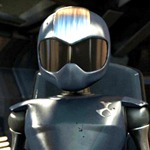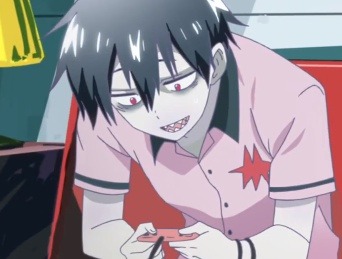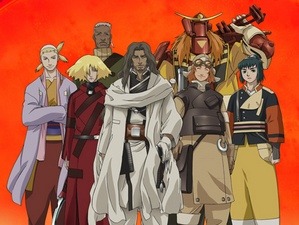The original creators of the Deadman Wonderland manga, Jinsei Kataoka and Kazuma Kondou, were at this year’s Anime Central, giving us the perfect opportunity to learn more about their thoughts on the series, its anime adaptation, and what they’re working on now. Dig into the full interview below.
Note: Unless otherwise indicated, Jinsei Kataoka provided the answers.
* * *
 The anime of Deadman Wonderland covered the first 21 chapters (give or take) of the manga, which leaves quite a bit of the overall story to be animated. Is there a certain part of Deadman Wonderland that didn’t make it into the anime that you’d personally love to see animated?
The anime of Deadman Wonderland covered the first 21 chapters (give or take) of the manga, which leaves quite a bit of the overall story to be animated. Is there a certain part of Deadman Wonderland that didn’t make it into the anime that you’d personally love to see animated?
The scene where Deadman Wonderland gets destroyed. Anime has movement and color, so it would be really exhilarating to see it animated in an over-the-top way.
The anime’s studio, Manglobe, shutting down caused a lot of people to give up hope for a season 2 of Deadman Wonderland. Is a second season still a possibility?
To be honest, I’m one of the people who have given up hope for a season 2 as well, but a lot of the anime staff were freelancers, so it could be possible, given the right opportunity…
(Spoilers) The ending of the manga sees a massive fight between Ganta and Shiro, which in turn causes the destruction of the Deadman Wonderland. In the final chapter, everyone seems to have gotten on with their lives. Ganta visits Shiro, who appears to be in a coma, but wakes up smiling in the last couple of pages. Has Shiro and Ganta’s story come to a close, or is there more for them on the horizon?
Their story of “sin” has come to a close, but now they should be able to write a new story for themselves.
What was it like to work on the Eureka Seven manga? Often times, adaptations go the other way around (manga becomes an anime). What’s the difference between working with an already existing universe, and one that you’ve created from scratch?
When you adapt something that already exists in another medium to manga, such as an anime or a play, the reader gets a chance to enjoy a different take on the material. When you’re acting as an artist for an original manga based on someone else’s vision, it requires a lot of work hashing out all of the details and ensuring their vision makes it onto the page.
When adapting preexisting works, you need to make sure the intentions of the original remain intact, but you also need to entice readers by making parts of it your own.
This one’s for Kataoka-sensei. You worked on another shorter series called Livingstone during Deadman Wonderland’s initial run. Is it difficult to work on two series at the same time?
It was very difficult for me, which is why partway through I decided to set a schedule and concentrate on one at a time.

What inspired the idea for weaponizing artificial limbs in Smokin’ Parade?
Kazuma Kondou was a big part of it. I think the idea itself is fantastic, but I couldn’t draw the limbs on my own, given my own personal style and artistic ability. We wanted to create a manga that would let Kazuma Kondou’s designs shine, and we both really loved this idea.
This is a little off-topic, but in Japan, handicapped people are often treated as weak social outcasts. On the other hand, there are a handful of examples in Japanese period dramas where disabled characters, such as Zatoichi and Tange Sazen, serve as heroes. We’re trying to do something similar, but in a modern setting.
Much like Deadman Wonderland, your current series – Smokin’ Parade – features quite a bit of that stuff we love: blood, violence, and gore. Do you ever have to take a break when drawing or writing these types of scenes, or does it even phase you anymore?
It’s easy to come up with ideas for gory scenes but drawing them is a lot of work. It takes forever (laughs). It does start to take a toll on you after a while, though. I think I could only ever get used to those sorts of things on paper. However, these types of scenes can elicit emotions from the reader and serve to create drama within the story. They can also be metaphorical as well, so they’re indispensable for us.
A few years ago, you had a one-shot called Kami-sama Permanent which had an interesting premise (a depressed God who attempts suicide and contemplates the meaning and value of life with another God – presumably an evil one). Was there ever any interest in expanding on this idea?
We’d never thought of expanding it into a series. We love that character of “God,” though, and had always wanted to create a manga about him.
Does any of your manga have any Western influences – whether that be movies, comics, books, or music?
Star Trek (in particular, The Next Generation) inspired us when we were working on the manga version of Eureka Seven. Other than that, as far as Western TV shows are concerned, I love Criminal Minds. Lost definitely inspired us as well. Kazuma Kondou is always watching Band of Brothers. We both love Person of Interest, Stranger Things, and Sherlock.
As for movies, I love all kinds of things: The Cell, The City of Lost Children, Paper Moon, Die Brücke, Quadrophenia, Radio Flyer, Cube, Kick-Ass, Six-String Samurai, Lock, Stock and Two Smoking Barrels, Hot Fuzz, and The Iron Giant.
Kondou doesn’t really read American comics, but he likes Mike Mignola’s stuff. Some of his favorite movies are Kingsman, Hot Fuzz, Saving Private Ryan, and Leningrad Cowboys Go America.
Excluding Deadman Wonderland, which series that you’ve created would you like to see animated?
We’d love to see Smokin’ Parade get animated.
Have you ever had any ideas for manga that didn’t quite get off the ground? If so, what are some of those?
We’ve had a bunch. For example, there’s one about a pet shop where the employees can see the ghosts of deceased pets. Each of them has a different specialty, such as birds, reptiles, dogs, etc., and their motto is “we’ll help take care of them, even after death.”
Another one is about a war where only women survive. It would be a quiet story, part fantasy, part science fiction, about them rebuilding all of the houses that were destroyed during the war. It doesn’t seem like something that would sell, so it’s something I’d just like to do for fun.





